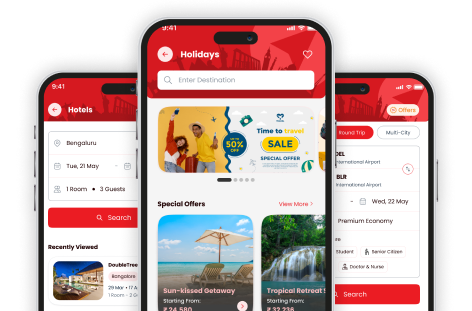Japan
Quick Facts
Full country name: Japan (Nihon)
Area: 377,835 sq km (147,356 sq mi)
Population: 126.9 million
Capital City: Tokyo (pop 12 million)
People: Japanese (including indigenous Ainu & Okinawans), Korean
Language: Japanese
Religion: Shinto, Buddhist, Christian
Government: Constitutional monarchy
Head of State: Emperor Akihito
Prime Minister: Yoshihiko Noda
GDP: US$3.15 trillion
GDP per head: US$24,900
Annual Growth: 1.3%
Inflation: -0.7%
Major Industries: High-tech electronic products, motor vehicles, office machinery, chemicals, steel, textiles, processed foods
Major trading partners: USA, Hong Kong, Taiwan, South Korea, Germany, China
Country Facts
Events:
January: Lucky Monday, when ceremonies are held for boys and girls who have reached the age of majority (20).
March: Hanami (Blossom viewing).
April: Golden Week (lumping together of Green Day, Constitution Day and Children’s Day from April 27 to May 6)
July: Gion Matsuri, held in Kyoto and is the most renowned of all Japanese festivals. The climax is a parade of massive man-dragged floats decked out in incredible finery, harking back to a 9th-century request to the gods to end a plague sweeping the city.
August: O Bon (Festival of the Dead), when lanterns are floated on rivers, lakes or the sea to signify the return of the departed to the underworld.
Currency:
Yen
When To Go
The best time to travel in Japan is autumn (September to November). The temperature is pleasant, and the autumn colours in the countryside are fantastic. Mid-winter (December to February) can be bitterly cold. And June to August are the sticky summer months.
Explore Attractions
Mt.Kenya
Mt.Kenya is the highest mountain in Kenya and the second-highest in Africa, after Kilimanjaro. It’s located in central Kenya. Mount Kenya is the source of the name of the Republic of Kenya.
Lake Nakuru
Lake Nakuru is one of the Rift Valley soda lakes at an elevation of 1754 m above sea level. It lies to the south of Nakuru, in the rift valley of Kenya. The lake’s abundance of algae attracts the vast quantity of flamingos that famously line the shore. Other birds also flourish in the area, as do warthogs, baboons and other large mammals. Black and white rhinos have also been introduced. Nakuru means Dust or Dusty Place in the Maasai language. The lake is world famous as the location of the greatest bird spectacle on earth – myriads of fuchsia pink flamingos whose numbers are legion, often more than a million – or even two million. They feed on the abundant algae, which thrives in the warm waters. Scientists reckon that the flamingo population at Nakuru consumes about 250,000 kg of algae per hectare of surface area per year.
Masai Mara
Masai Mara National Reserve
The Mara (as the old hands like to call it) is the most popular wildlife park in Kenya. Abounding with wildlife and joined to the Serengeti, this 320-sq-km reserve is anything but plain. Few visitors miss roaming at least part of its vast open savanna grasslands – or leaping out of the way of the annual wildebeest stampede. The western border of the park is the spectacular Esoit Olooloo (Siria) Escarpment and it’s at the edge of the park that the concentrations of wildlife are the highest. Lions are found in large prides everywhere and it’s not unusual to see them hunting. Elephants, buffaloes, zebras, various antelopes and hippos also exist in large numbers.
Nairobi
Kenya’s capital is cosmopolitan, lively, interesting, pleasantly landscaped and a good place to get essential business matters sewn up. You can walk from one end of the central business district to the other in 20 minutes and it’s a great place to tune into modern urban African life. Unfortunately, it’s also a great place to get mugged.
Nairobi sprang up with the building of the Mombasa to Uganda railway. Originally little more than a swampy watering hole for Maasai tribes, it had became a substantial town by 1900. Five years later it succeeded Mombasa as the capital of the British protectorate. Today it’s the largest city between Cairo and Johannesburg with a population of 2.5 million and a rapid growth rate.
Like most cities, Nairobi has its crowded market, trading and transport areas, its middle class/office workers’ suburbs and its spacious mansions and flower-decked gardens for the rich and powerful. For sightseeing, the National Museum, Snake Museum and National Archives are all interesting and easy to get to.
Nairobi is a city of contrasts – you will find smart office workers and mansions and expensive suburban shopping centers as well as overcrowded slums and a lot of people trying to struggle on as best they can. Crime in River Rd and some other areas of Nairobi is a major problem (travelers have come to call the place ‘Nairoberry’). For all that, Nairobi is also a place to find things that you can’t buy in most other parts of Africa. It has the latest films on big screens, a variety of excellent restaurants and a number of cafes and bars full of travelers from all over the world swapping safari stories.
Population: 2.5 million
Country: Kenya
Time: GMT/UTC +3 hours
Telephone Area Code: 02
Events:
The Nairobi agricultural show is held in the first week of October and is attended by local tribal people. Apart from this, there are celebrations during national holidays that include Madaraka Day (1 June), which celebrates self-government, Kenyatta Day (20 October) and Independence Day (12 December).
Orientation:
The compact city center is bounded by Uhuru Hwy, Haile Selassie Ave, Tom Mboya St and University Way. The main bus and train stations are within a few minutes walk of this area. The main budget accommodation area is centered on Latema Rd, just east of Tom Mboya St. The National Museum is to the north of the central area, while Westlands, a major shopping center, is further north.
When to go:
The best times to visit are during January and February and between June and October, when the weather is drier in and around Nairobi. Because Nairobi is located at the edge of the highlands, temperatures are cooler here compared with much of the rest of the country.
Beaten Track:
Karen Blixen Museum
This is the beautiful farmhouse where Karen Blixen, author of Out of Africa, lived between 1914 and 1931, until she left Kenya after a series of personal tragedies. Nearby are the Ngong Hills, where many white settlers set up farms and built their houses. Passing by this area, you can be excused for imagining you are in the Home Counties of England, which along with the cooler temperatures goes a long way to explain why the Europeans settled here in such numbers. Though the hills offer some excellent walks, you should only do one with an organized tour or an armed escort, due to the risk of being mugged.
Limuru
Limuru has a distinctly European feel. Kentmere Club is the quintessential white-settlers’ club and is well worth a visit. Kiambethu Tea Farm offers tours of its tea estate at nearby Tigoni. Limuru is northwest of Nairobi. The bus ride takes about half an hour, followed by a ten-minute walk.
Nairobi is an excellent place to go on a safari or a trek up Mt Kenya. Gaining popularity is white-water rafting on the Athi/Galana River. Otherwise, why have you gone all the way to Kenya?hell are you doing in Nairobi?
History:
Until the 19th century, you could find only the Maasai people in Nairobi. Then came the building of the Mombasa to Uganda railway, and the place became a convenient and relatively cool place for the Indian railway laborers and their British overlords. Nairobi quickly became a tent city and a supply depot. By 1900 it was a town with substantial buildings; five years later and it replaced Mombasa as the capital of the British East Africa Protectorate.
White settlers soon began to move into the fertile highlands north and then south of Nairobi. This led to friction with the local Maasai and, later, the Kikuyu. Mixed agricultural farms were set up, with coffee plantations established at about the same time by new arrivals that included Karen Blixen and her husband, Brer. The number of white settlers rose to 9000 by 1920 and, by the 1950s, it was 80,000. Alienated from their land, many Kikuyu people migrated to Nairobi during the same period, became part of the colonial economy, and formed associations whose principal aim was the return of land to the Kikuyu. One such person was Johnstone Kamau, who later changed his name to Jomo Kenyatta.
Up until after WW II, Kenya’s white rulers were in no mood for accommodating the demands of the Africans. However, African troops returning from the war were equally in no mood to accept the status quo and the bloody Mau Mau Rebellion, which mainly involved the Kikuyu, raged until 1956. Soon afterwards, Kenyatta was jailed and later placed under house arrest until 1961, although there was no evidence to link him with the rebellion. Pressure continued to build on the British and, on 12 December 1963, Kenya gained independence, with Kenyatta as its first president. Throughout the 20th century, Nairobi continued to grow. Today, it is now the largest city between Cairo and Johannesburg.
Getting There:
Fying is the most convenient way to get to Nairobi. It is a major African hub, so flights between the city and the rest of Africa and many other destinations in Europe are frequent and relatively cheap. Coming overland, Nairobi is easily reached by bus and minibus from various destinations in Tanzania and Kampala in Uganda. To arrive from Ethiopia, you will have to get on a truck (which will be part of an escorted convoy) from the border at Moyale and swap to a bus at Isiolo. Within Kenya, Nairobi can be reached from Mombasa by either train or bus, while long-distance buses and minibuses run to numerous destinations.
Getting Around:
There’s a cheap bus to/from the international airport, but many travelers report being ripped off on it. Buses are a cheap way of getting around Nairobi, but they can be very crowded during peak hour and are a pickpocket’s paradise. Matatus (minibuses) are much the same, although they tend to be more frequent and their drivers often crazier. Taxis are not metered and expensive, but vital for night travel for safety reasons.
Activites
Hiking routes exist in many of Japan’s national parks. To experience a Japan that few foreigners see, head for the mountainous, less populated Central Alps. Skiing is possible here from December to April. The Okinawan islands in the far south-west of Japan are popular diving destinations. Cycling is most popular in the less hilly coastal regions.
Visa
Japan Tourist Visa Requirements
Documents Required –
Visa Application form duly filled and singed as per passport. (Note – If thumb impression is there on the passport of child then on visa form along with thumb impression signature of both parents is required)
Valid passport with minimum 6 months validity from date of exit from Japan after the tour.






